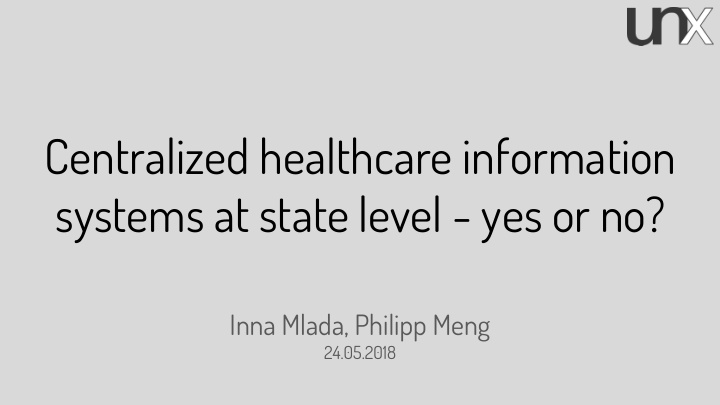



Centralized healthcare information systems at state level - yes or no? Inna Mlada, Philipp Meng 24.05.2018
Terminology & disambiguation
“Centralized healthcare information systems at state level” centralized….? healthcare information systems…? state level…?
Centralized System: Economy point of view Same system for logistics, accounting … and clinical documentation: lower purchasing cost ● lower maintenance cost ● easy adaptation to changing procedures, reimbursement alterations ● integrated systems - all in one/one for all - are available ● transparency ● complex reporting including clinical data ● cost control ● transfer of personnel ●
Centralized system: Operating point of view Central Data Center Server infrastructure and data storage ● Redundancy & emergency power supply ● Specialists for operating and maintenance of the system ● Infrastructure National networks ● Redundancy ●
Centralized system: Point of view Data Patient improved patient security ● reduction of double examinations (e.g. radiology, laboratory by 25%) ● reduction of hospital stay length by 30% ● Physician data from all other healthcare providers is available ● reduction of double data input ● improved treatment efficiency ● data for scientific questions available ●
Healthcare information system Umbrella term for: Hospital information system ● Radiology information system ● Laboratory information system ● Pharmacy information system ● Family doctors documentation system ● ... ●
State level State level as for the whole country - “national” state level ● for the federal state - “country” state level ●
What do we have?
What do we have? Technic is available or could be purchased: Hardware ● Software ● Infrastructure and networks ● The challenge to win people: healthcare professionals ● hospital managers ● political decision ● patients/voters ●
Where are the others?
Stories from others - national state level Denmark - Sundhed.dk (2001 - 2003 - *2009) England - NHS “Spine” (2002- 2009 - +2013) Lithuania - National electronic health system (2009 - * ….. 2016) Germany - EFA “elektronische Fallakte” (2006 - 2013 - +??) Austria - ELGA “elektronische Gesundheitsakte” (2006- 2012 - *2022)
Stories from others - country state level Spain - Extremadura (all in one/one for all) Finland - Helsinki Area (Appotti) (all in one/one for all) Austria - all 9 federal states (5 all in one/one for all - 4 heterogenous information system) Austria - private hospital providers (heterogeneous information system)
KAGes - Styria, Austria Road to openMEDOCS: Project “NEW System Structure” ● 1998 - 1999; Result: Vendor selected via Tender ○ Project “MEDOCS” Pilot implementations - one “country hospital” and one department of a ● university hospital, Radiology, Billing, Research and Data Mining 1999 – 2002; Result: Decision for Rollout ○ Programm “openMEDOCS” ● 2003 - 2005; Result: Operation of the new system in all 23 Hospitals ○ KAGes: 13 hospitals on 22 locations, 4 nursing homes; 17.500 employees ca. 6.000 beds, ca. 1 mio. outpatients and 270.000 inpatients/year
Steps to a centralized healthcare information system
Step 1 Analyze actual infrastructure (data centers, network, redundancy, client infrastructure) ● current software used (primary + secondary - tertiary healthcare) ● processes and standards of the healthcare providers (patient management flow) ● stakeholders (who is affected? not only primary + secondary - tertiary healthcare - all ● affected professional groups)
Step 2 Discuss politically - is the project possible with current laws? discuss financing, operation, ● organisation, coarse roadmap with the hospital management - dimension of the project, coarse roadmap ● with the stakeholders - what are the possibilities, what are the pitfalls, motivational factors ● - keep the motivation high with the patients - act, do not react - start earliest possible with information of the patients ● ethical aspects - data breach, second opinion, confidentiality ●
Step 3 Plan Plan the approach ● examine scenarios - stepwise vs. regional rollout ○ Plan time and resources ● Plan occuring problems - Murphy’s law! ● Plan the cost of the project in the different scenarios ●
Step 4 Check and Decide decide politically on the results of the analysis, the scenarios, the coarse roadmap and ● timeline, the cost coverage check if the legal prerequisites are fulfilled ● decide on standards for communication in your healthcare system ● decide on what is to be centralized, what stays locally ●
Step 5 Seek partners for the hardware and software rollout ● professionals for the detailed analysis and rollout directly at the end users ● the right software for your needs ● the right hardware for your needs ● the right infrastructure for your needs ●
and all the time Keep in mind data security - avoid data breaches ● access control - most granular possible ● ethical aspects - confidentiality, “right to forget” ● keep motivation of all players high - this includes all healthcare profession groups and also ● patients
Centralized healthcare information system? YES
Benefit - for the patients less double treatments (radiology and labs by 25%) shorter treatments (30%) efficient communication between primary and secondary care efficient healthcare system -> shorter waiting time for critical procedures
Benefit - for the healthcare professionals availability of patient data → treatment security, support for decision making motivated personnel due to efficient and functional system more cases (data) for clinical research and investigation - “clinical” data warehouse less administration activity -> more time for patients specialisation and optimal distribution of the patients → motivation
Benefit - for the management transparency → comparability → cost control → steering tools quality management reporting and as a long term goal: prognosis and modeling of different scenarios lower operating cost transferable personnel increasing of efficiency due to data availability capacity distribution, steering patient flow, maximizing utilisation
Benefit - for the ministry of health transparency and comparability of healthcare providers -> identification of the best point of care data analysis for demographic and epidemiologic questions population health/public health -> Control of the effect of taken measures in prevention tackling human threats -> Antibiotic resistance
A journey of a thousand miles begins with a single step. Confucius Dipl.-Ing. Inna Mlada Dr. Philipp Meng mli@unkomplex.at mph@unkomplex.at
Recommend
More recommend